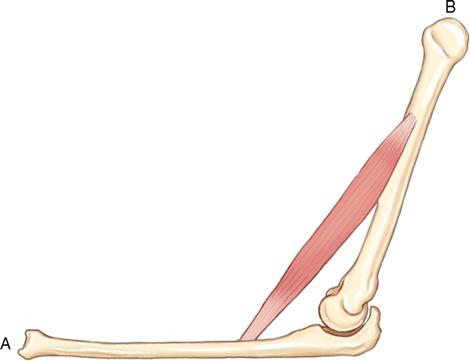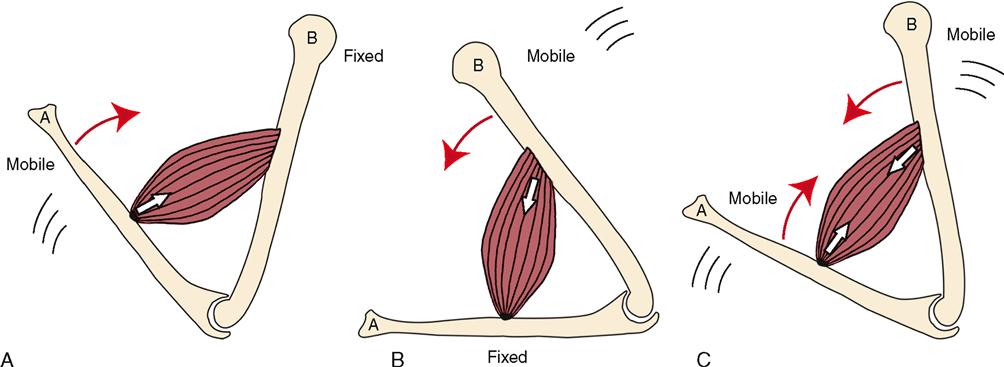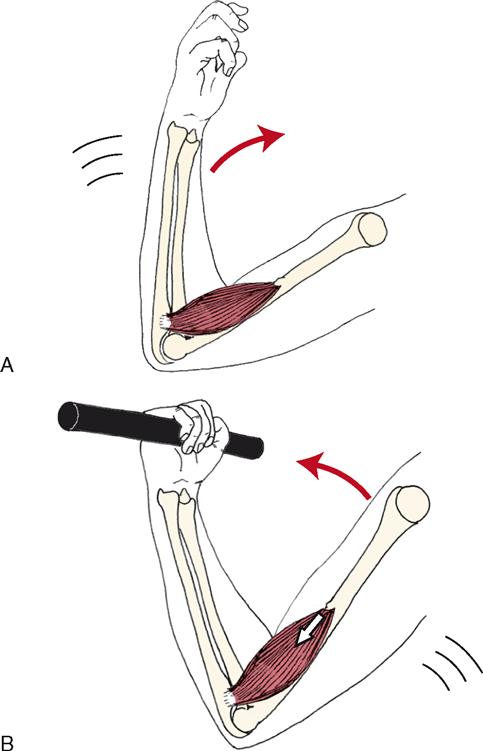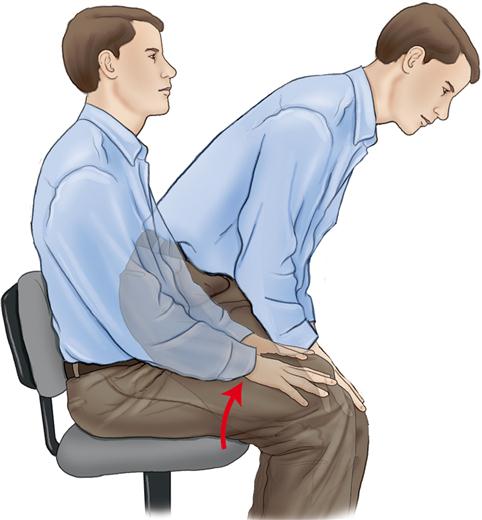How Muscles Function
MUSCLES CREATE PULLING FORCES
The essence of muscle function is that muscles create pulling forces. It is as simple as that. When a muscle contracts, it attempts to pull in toward its center. This action results in a pulling force being placed on its attachments. If this pulling force is sufficiently strong, the muscle will succeed in shortening and will move one or both of the body parts to which it is attached. Realizing that this pulling force is equal on both of its attachments is also important. A muscle does not and cannot choose to pull on one of its attachments and not the other. In effect, a muscle is nothing more than a simple “pulling machine.” When ordered to contract by the nervous system, it pulls on its attachments; when not ordered to contract, it relaxes and does not pull (Box 3-1).
Determining whether there is a cognate (i.e., a similar term in lay English) is usually extremely helpful when confronted with a new kinesiology term. This helps us understand the new kinesiology term intuitively instead of having to memorize its meaning. When it comes to the study of muscle function, the operative word is contract because that is what muscles do. However, in this case, it can be counterproductive to try to understand muscle contraction by relating it to how the term contract is defined in English. In English, the word “contract” means “to shorten.” This leads many students to assume that when a muscle contracts, it shortens. This is not necessarily true, and making this assumption can limit our ability to truly grasp how the muscular system functions. In fact, most muscle contractions do not result in the muscle shortening; to examine the muscular system in this way is to overlook much of how the muscular system functions.
WHAT IS A MUSCLE CONTRACTION?
When a muscle contracts, it attempts to shorten. Whether or not it succeeds in shortening is based on the strength of its contraction compared with the resistance force it encounters that opposes its shortening. For a muscle to shorten, it must move one or both of its attachments. Therefore the resistance to shortening is usually the weight of the body parts to which the muscle is attached. Let’s look at the brachialis muscle that attaches from the humerus in the arm to the ulna in the forearm (Figure 3-1).
For the brachialis to contract and shorten, it must move the forearm toward the arm or move the arm toward the forearm or both. The resistance to moving the forearm is the weight of the forearm plus the weight of the hand that must move (go along for the ride) with the forearm. The resistance to moving the arm is the weight of the arm plus the weight of much of the upper part of the body that must move (go along for the ride) when the arm moves toward the forearm. Consequently, for the brachialis to contract and shorten, it must generate a force that is greater than the weight of the forearm (and hand) or the arm (and upper body). Because the forearm and hand weigh less than the arm and upper body, when the brachialis contracts and shortens, the forearm usually moves, not the arm. Thus the minimum force that the brachialis must generate if it is to contract and shorten is the weight of its lighter attachment—the forearm.
However, even if the brachialis contracts with insufficient strength to shorten, it is important to understand that it is still exerting a pulling force on its attachments. This pulling force can play an important role in musculoskeletal function. When a muscle’s function is described, it is usually stated in terms of its joint actions, which are its shortening contractions. For this reason, the tendency is to focus on the shortening contraction of a muscle and overlook the importance of its contraction when it does not shorten.
Concentric Contraction
Let’s first look at what happens when a muscle contracts and does shorten. A shortening contraction of a muscle is called a concentric contraction. The word “concentric” literally means “with center.” In other words, when a concentric contraction occurs, the muscle moves toward its center. As we have said, for a muscle to contract and shorten, it must move at least one of its attachments. Let’s explore the idea of concentric contraction by looking at a “typical” muscle (Figure 3-2).
A muscle attaches to two bones and, in doing so, crosses the joint that is located between them (Box 3-2). Let’s call one of the attachments A and the other attachment B. When the muscle contracts, it creates a pulling force on both bones. If this pulling force is strong enough, then a concentric contraction can occur in three possible ways: (1) the muscle can either succeed in pulling bone A toward bone B, (2) it can pull bone B toward bone A, or (3) it can pull both bones A and B toward each other (Figure 3-3). The bone that moves is described as the mobile attachment, and the bone that does not move is described as the fixed attachment. For a concentric contraction to occur, at least one of the attachments must be mobile and move. Regardless of which attachment moves, when a muscle contracts and does generate sufficient force to move one or both of its attachments, it is the mover of the joint action that is occurring and called the mover or agonist. By definition, when a mover muscle contracts, it contracts concentrically.
If we now explore concentric contraction a little further and ask which attachment will be the mobile one that does the moving, the answer will be the one that offers the least resistance to moving. That attachment will usually be the lighter attachment. When we are looking at muscles on the extremities of the body, the lighter attachment is usually the distal one. In the upper extremity, the hand is lighter than the forearm, the forearm is lighter than the arm, and the arm is lighter than the shoulder girdle/trunk. In the lower extremity, the foot is lighter than the leg, the leg is lighter than the thigh, and the thigh is lighter than the pelvis. Furthermore, as we have stated, for the more proximal attachment to move, the core of the body must usually move with it, which adds even more weight and resistance to moving. Consequently, when a muscle concentrically contracts, it usually moves its distal attachment. For this reason, when a muscle’s joint actions are learned, they are usually presented and demonstrated with the proximal attachment fixed and the distal attachment mobile. These actions are termed the standard mover actions of the muscle.
Reverse Actions
Although the more common and typically thought of muscle action (the standard action) is one in which the proximal attachment stays fixed and the distal attachment moves, this is not always the case. In fact, often it is not. Let’s look at a concentric contraction of the brachialis muscle across the elbow joint. When the brachialis contracts, it would most likely move the distal attachment toward the proximal attachment, moving the forearm and hand toward the arm (Figure 3-4, A). However, if the hand holds onto an immovable object such as a pull-up bar, then because the hand is fixed, the forearm is also fixed and cannot move unless the pull-up bar is ripped off the wall. Therefore the arm will now offer less resistance to moving than the forearm, and if the brachialis contracts with sufficient force to move the arm (and the weight of the trunk that must move with it), the arm will be moved toward the forearm and the person will do a pull-up (Figure 3-4, B). When the proximal attachment moves toward the distal attachment instead of the distal one moving toward the proximal one, it is called a reverse mover action. In this scenario, therefore, flexing the forearm toward the arm at the elbow joint is the typically thought of standard action, and flexing the arm toward the forearm at the elbow joint is the reverse action. For every standard action of a muscle, a reverse action is always theoretically possible.
How often reverse actions occur varies across the body and is also based on what motions and activities are being performed. In the upper extremity, reverse actions usually occur whenever the hand is gripping an immovable object. A pull-up bar as illustrated in Figure 3-4, B, is one example of this. Many other examples in everyday life exist, such as using a banister when walking up the stairs, someone helping to pull you up from a seated to standing position, and a disabled person using a handicap bar.
In the lower extremity, reverse actions are extremely common because much of the time when we are standing, seated, or walking, our foot is planted on the ground. Unless we are on ice or some other slick surface, our foot is at least partially fixed and resistant to moving, resulting in our leg moving toward the foot. Similarly, with the distal end fixed, the thigh would have to move toward the leg and the pelvis would have to move toward the thigh.
An excellent example of this is when we use our quadriceps femoris muscle group to stand from a seated position (Figure 3-5). We usually think of the quadriceps femoris group as extending the leg at the knee joint. But in this case, it must perform the reverse action of extending the thigh at the knee joint. As the thighs extend at the knee joints, the rest of the body must also be lifted. If you palpate the quadriceps femoris in your anterior thighs as you stand up from a seated position, you will easily feel their contraction. In fact, it is because of this frequent activity of daily life that our quadriceps femoris group needs to be large and powerful.
In the axial body, we do not use the terms proximal and distal. Usually, standard muscle action moves the superior attachment toward the inferior one. This is because the upper axial body (head, neck, and upper trunk) is both lighter than the lower axial body (lower trunk) and because when we are sitting or standing, our lower body is more fixed and, consequently, more resistant to moving. Therefore when a muscle of the axial body moves the lower trunk toward the upper trunk, neck, and head, it is a reverse mover action. These reverse actions happen quite often when we are lying down, for example, when moving in bed, or when doing floor exercises.
When students first study muscle system function and the specific actions of muscles, it is extremely important not to develop a too rigid mindset and look only at a muscle as moving its distal (or superior) attachment when it concentrically contracts. Remember, a reverse mover action is always theoretically possible. Although some rarely occur, others occur frequently and play an integral part of everyday movement patterns and activities. In this text, when a muscle is discussed, both standard and reverse actions are presented.
NAMING A MUSCLE’S ATTACHMENTS: ORIGIN AND INSERTION VERSUS ATTACHMENTS
The classic method to name a muscle’s attachments is to describe one attachment as the origin and the other as the insertion. Although the exact definitions have varied, the origin is usually defined as the more fixed attachment and the insertion as the more mobile attachment. Because the proximal attachment is usually the more fixed attachment and the distal attachment is usually the more mobile attachment, some medical dictionaries even define the origin as the more proximal attachment and the insertion as the more distal attachment.
In recent years, the use of the terms origin and insertion has been decreasing in favor. Perhaps the reason is that teaching students who are first learning muscles that one attachment of the muscle is usually fixed tends to promote the idea that it is always fixed. This belief can lead to less flexibility in how the students view muscular function because they tend to ignore the reverse actions of muscles wherein the insertion stays fixed and the origin moves. Given how often these reverse actions actually occur can handicap the student as he or she begins to use and apply muscle knowledge clinically with clients.
For these reasons, naming a muscle’s attachments by simply describing their locations is gaining favor. After all, if the origin can also be defined as the proximal attachment and the insertion can also be defined as the distal attachment, why not skip use of the terms origin and insertion entirely and simply learn the names of the attachments as proximal and distal? Or, if the muscle is running superiorly and inferiorly or medially and laterally, simply naming the attachments using these locational terms is not only simpler, but it also has the advantage of pointing out to the student the fiber direction of the muscle. This helps the student see the muscle’s line of pull, which is the most crucial step in figuring out its actions.
At present, both naming systems are used in the field of kinesiology, therefore being comfortable and conversant with both is important. For this reason, this text uses both origin/insertion (O and I) terminology and attachment terminology. Most importantly, the student must learn that a muscle has two attachments; either one can potentially move, and what determines which one actually does move in any particular scenario depends on its relative resistance to being moved.
ECCENTRIC CONTRACTIONS
We have already discussed concentric contractions. They occur when a muscle contracts with a force that is greater than an attachment’s resistance force to moving. Therefore the muscle moves the attachment and succeeds in shortening. As previously stated, a muscle does not always succeed in shortening when it contracts.
If a muscle contracts, attempting to pull in toward its center, but the resistance force is greater than the muscle’s contraction force, not only will the muscle not succeed in shortening, but the muscle’s attachment will actually be pulled farther away from the center of the muscle. A lengthening of the muscle as it contracts will be the result. A lengthening contraction is defined as an eccentric contraction.
Eccentric contractions happen most often when a muscle is working against gravity. For example, if I am holding an object and want to lower it down to a tabletop, I can let gravity bring my forearm and hand down. However, if the object is fragile, I need to lower it slowly so that it does not crash down onto the table and break. This requires me to contract musculature that opposes gravity so that the object can be lowered slowly and safely (Figure 3-6). In this example, the purpose of the muscle contraction is not to beat gravity and raise the object; rather, its purpose is to lose to gravity but to do so slowly so that the effect of the force of gravity is slowed and the object is lowered slowly. Therefore the purpose of an eccentric contraction is to slow or restrain a joint action that is caused by another force, usually gravity. Because the muscle that eccentrically contracts opposes the joint action movement that is occurring, it is called the antagonist. By definition, when an antagonist muscle contracts, it contracts eccentrically (Box 3-3).
Stay updated, free articles. Join our Telegram channel

Full access? Get Clinical Tree












